One bite of Beef Rendang and you’ll see why it’s one of the world’s most beloved beef dishes. This Indonesian comfort food slowly braises beef in a deeply satisfying and complex sauce flavored with bold spices, creamy coconut milk, and a touch of heat. It may not be the quickest meal around, but I promise the flavor-rich bites are well worth your time and patience.
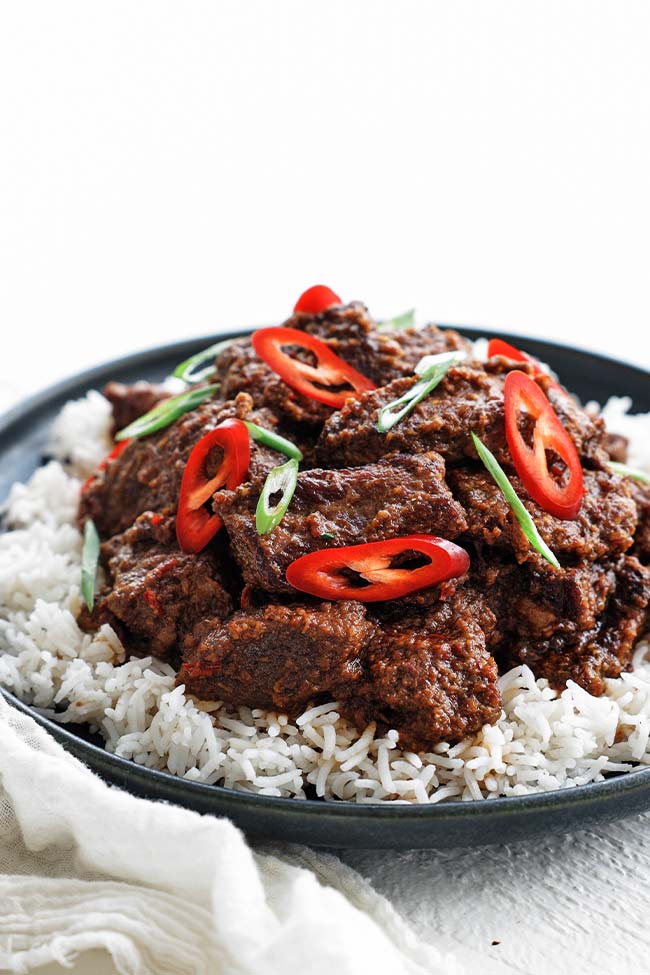
We aren’t big beef eaters in our house, unless it’s a special occasion or the meat’s been slow-cooked until it melts in our mouths. If you’re the same, then I know you’ll love this Boeuf Bourguignon for celebrations and my Classic Pot Roast for Sunday night dinners.
What is Beef Rendang?
Beef rendang is a traditional Indonesian braised beef dish said to have been created by the Minangkabau people. Its deep, layered flavors and the slow cooking process make it truly something special, so it’s no surprise that it’s traditionally made for special occasions.
My version stays true to the spirit of authentic Indonesian beef rendang. I slow-cooked chuck steak to melt-in-your-mouth perfection in a thick, intensely flavorful sauce that coats every piece, locking in its naturally rich flavors. It’s the kind of dish that feels luxurious but is surprisingly doable at home if you give it the time it deserves. Serve it over steamed rice or coconut rice, add a few simple sides, and you have a meal that’s every bit as mouthwatering as it sounds.
Ingredients and Substitutions
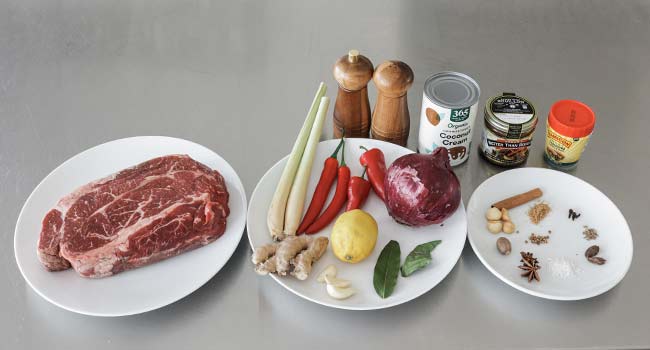
- Coconut — This beef rendang recipe wouldn’t be complete without the toasted coconut paste (AKA kerisik). After all, it’s responsible for rendang’s signature richness. Remember to buy unsweetened coconut, as the natural sugars will reveal themselves and sweeten the sauce over time.
- Oil – I like searing the beef and sautéing the aromatics with avocado oil, but any neutral oil will work here.
- Beef – Just like with pot roast, a well-marbled chuck steak is my go-to for rendang because the fat gradually breaks down as it’s slow-cooked. You could substitute beef short ribs or brisket, but chuck is the classic choice for good reason.
- Chilies – I used a mix of one whole and seven seeded Fresno peppers, plus lady finger peppers. Fresno peppers add a lovely fruity spice, while lady finger peppers bring the fiery bite you expect. You can usually find both types at Asian markets or specialty grocers.
- Aromatics — The intensely fragrant foundation of the beef rendang curry sauce is a blend of finely minced shallots, garlic, lemongrass, and ginger. If you can’t find fresh lemongrass, use lemongrass paste as a substitute.
- Spices — I toasted a mix of whole spices, such as cardamom pods, a cinnamon stick, cloves, cumin seeds, coriander seeds, nutmeg, and star anise, before grinding them into an incredibly fragrant spice mix. You can use ground spices to speed up the process, but whole spices will give you the most authentic results.
- Nuts – I blended macadamia nuts into the spice mix to help thicken and enrich the rendang. Raw cashews work well as a substitute.
- Herbs – Fresh bay leaves and lime leaves (makrut lime) infuse the rendang with layers of aroma while it simmers. If you can’t find lime leaves, add extra lemongrass and a splash of lime juice toward the end of cooking.
- Coconut Milk — Canned full-fat coconut milk is the only option for this dish, as the fat content is crucial for developing that glossy, luscious sauce.
- Sugar — I used traditional palm sugar to help balance the spices and heat, but light brown sugar works, too.
How to Make the Best Beef Rendang
Kerisik: First, I add the shredded coconut to a large wok or non-stick skillet set over low heat and move it around with a spatula until it turns light golden brown. I transfer it to a mortar and pestle and process it until it turns into a rich, oily paste. Once the kerisik is ready, I transfer it to a bowl for later.
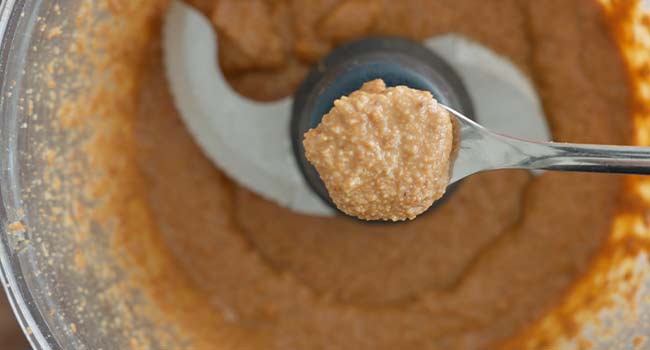
Sear: Next, I heat the oil in a large rondeau pot over high heat. Working in batches, I spread the beef in an even layer in the pot, season it with salt and pepper, and sear it for about 2 minutes per side. When it’s done, I set the meat aside on a plate.
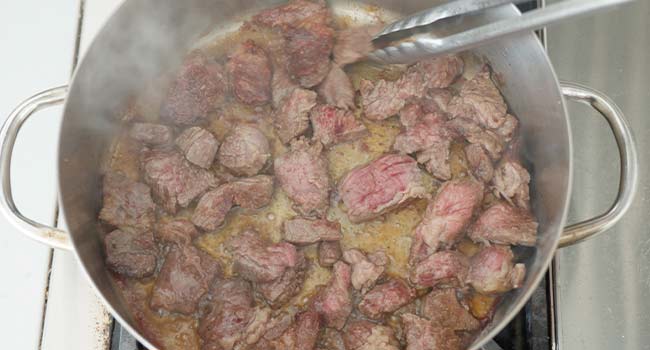
Sauté: I sauté the shallots in the now-empty pot with the rendered beef fat until browned. I add the garlic, ginger, and lemongrass and sauté the mixture for a few minutes.
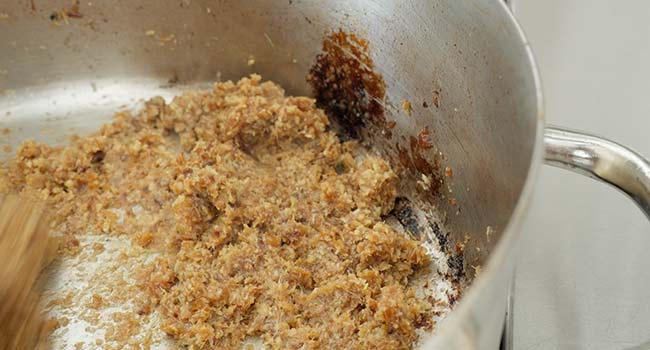
Toast: While the aromatics are sautéing, I gently toast the whole spices and macadamia nuts in a medium pan over low to medium heat until fragrant. Then, I transfer everything to a spice grinder or mortar and pestle and grind it into a fine spice mix.
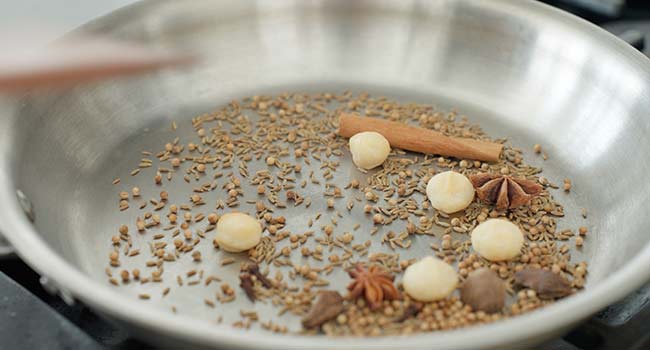
Build: Back at the main pot, I stir the minced peppers before adding the ground spice blend. I let this mixture cook for a few minutes.
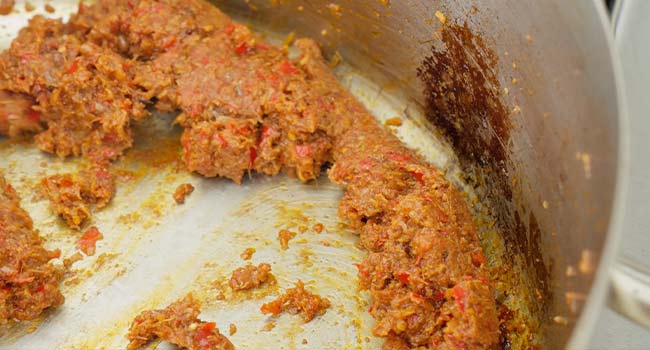
Return: I return the seared beef to the pot and let everything cook together before tossing in the bay leaves and lime leaves.
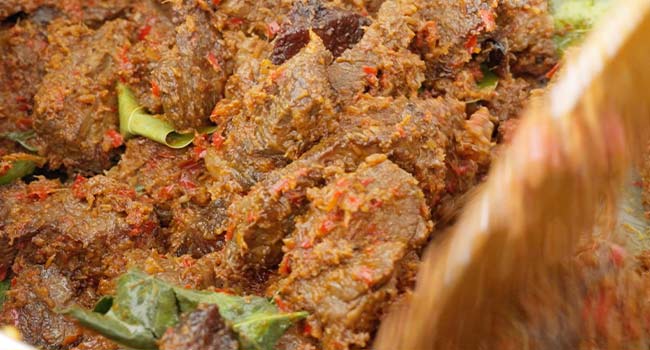
Simmer: I stir in the coconut milk, sugar, some of the kerisik, and a pinch of coarse salt. Finally, I lower the heat and let the rendang simmer uncovered for about 3 hours. Return every 30 minutes or so to stir it.
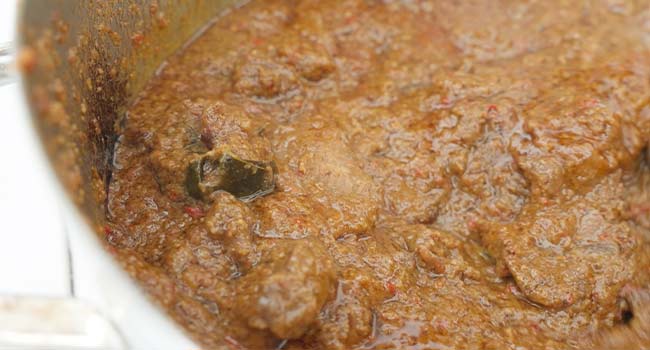
Slow Cooker Instructions
To make this beef rendang recipe in a slow cooker, toast the coconut. Then sear the beef, and cook the aromatics and spices as usual before transferring everything to a slow cooker. Stir in the coconut milk, sugar, coconut paste, and seasonings, then cover and cook on LOW for 8 hours.

Chef Tips + Notes
Resist the urge to rush the process or crank up the heat when making beef rendang. This dish is a labor of love that rewards patience. Trust that with time, the beef will become fork-tender and the sauce will come together flawlessly.
- Toast the coconut with care: At first, the shredded coconut will feel like it is taking a long time to toast. Don’t walk away from the stove—as soon as it starts browning, it can burn in an instant, and burnt coconut will leave you with a bitter-tasting kerisik.
- Prepare the beef the right way: Before searing, cut the beef into uniform pieces (about 2” x 1” x ½” each). The pieces of meat should be large enough to hold their shape but still small enough to soak up flavor.
- Use a heavy-bottomed pot: You want something that conducts heat evenly and has plenty of surface area. A wide, heavy rondeau pot, Dutch oven, or deep sauté pan is a great option.
- Watch for the fat to separate: As the beef simmers, you’ll notice the fat from the coconut milk start to separate and rise to the top. That’s what you want to see! This means the sauce reduces properly and becomes rich, clingy gravy.
- Want to try it with chicken? Chicken rendang is a popular variation. Use bone-in, skin-on chicken thighs and simmer them over low heat for about an hour, or until the sauce thickens and the chicken is fall-off-the-bone tender.
Serving Suggestions
I love serving this rendang recipe with a big scoop of perfectly fluffy rice. If you want to take it to the next level, coconut rice is an even better pairing. The subtle sweetness and creaminess perfectly balance the deep, savory flavors of the stew.
If you’d like to round out the meal with traditional Indonesian sides, the bright, tangy crunch of pickled vegetables such as pickled carrots or cauliflower cuts through the richness, while a side of naan or roti is perfect for scooping up every last bit of the sauce.
Make-Ahead and Storage
Make-Ahead: Beef rendang can be made a few hours before serving. Keep it covered on the stovetop over low heat until it’s time to eat.
How to Store: Once cooled, transfer the leftovers to an airtight container and store them in the refrigerator for 5 days. The rendang also freezes well for up to 3 months. Let the leftovers thaw in the fridge overnight before reheating.
How to Reheat: Reheat the beef and sauce in a saucepan over low heat, adding a splash of water or coconut milk if needed to loosen the sauce, until heated through.
More Asian-inspired Recipes

Video
Beef Rendang Recipe
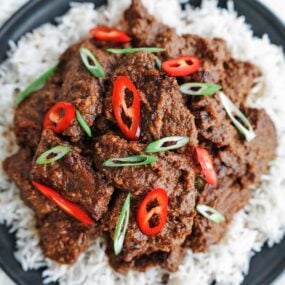
Ingredients
For the Beef:
- 3 cups shredded unsweetened coconut
- 4 tablespoons avocado or another neutral flavored cooking oil
- 3 pounds chuck steak, cut into 2” x 1” x ½”
- 1 whole Fresno pepper and 7 seeded Fresno peppers, finely minced/ground
- 2 seeded lady finger peppers, finely minced/ground
- 6 shallots finely minced, about 1 cup
- 8 garlic cloves finely minced
- 3 stalks of lemon grass finely minced, ends and outside layer removed
- 3 tablespoons of finely minced ginger, about a 3” pieces – peeling can remain on if rinsed
- Juice of ½ lemon, about 1 ½ tablespoons
- Coarse salt and freshly cracked pepper to taste
For the Spice Blend:
- 2 cardamom pods
- 1 cinnamon stick
- 3 cloves
- 1 tablespoon cumin seeds
- 2 teaspoons of coriander seeds
- Half of a nutmeg
- 2 star anise
- 5 macadamia nuts
- 4 bay leaves
- 4 lime leaves
- 3 15- ounce cans full fat coconut milk
- 2 teaspoons palm sugar or light brown sugar
Instructions
- Add the shredded coconut to a large wok or non-stick skillet over low heat. Constantly move it around using a spatula and cook it until it is light golden brown, about 25 minutes. Once browned, transfer to a mortar and pestle or food processor and process until it becomes a runny paste. You will need to stop and scrape a few times. Set it to the side in a bowl.
- Add the oil to a large rondeau pot over high heat. Once it begins to smoke lightly, add the beef in batches and spread it out across the pan. Season with salt and pepper and sear for 2 minutes per side. Set the meat aside on a plate, and repeat with the remaining uncooked beef.
- Turn the heat down to low-medium. Add the minced shallots to the pan with the rendered meat fat, season with salt, and cook for 12 to 15 minutes while frequently stirring, or until browned. Then, add the garlic, ginger, and lemon grass and cook for 5 to 6 more minutes.
- In the meantime, add the cardamom, cinnamon, cloves, cumin, coriander, nutmeg, anise, and macadamia nuts to a medium-sized sauté pan and cook over low to medium heat for 4 to 6 minutes or until they become very fragrant. Transfer to a mortar and pestle or spice grinder and grind until finely ground. Set aside.
- Return the onions, garlic, ginger, and lemon grass to the pan. Add the finely ground/minced peppers and cook for 4 to 5 minutes. Then, add the ground spices and cook for 2 to 3 minutes.
- Return the beef to the pan and cook for 2 to 3 minutes. Add in the bay leaves and lime leaves and stir to combine.
- Next, add the coconut milk, sugar, about ½ cups of the finely ground coconut shreds, and coarse salt, and stir to combine.
- Cook over low heat, uncovered, for about 3 hours or until the meat is extremely tender. Be sure to return every 20 to 30 minutes to stir and move things around. If the coconut milk fat is separating, you know you’re on the right track. When it’s done, the sauce should become like a thick paste.
- Serve the beef rendang over rice.


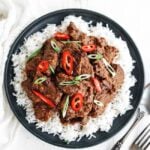
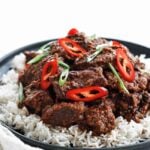
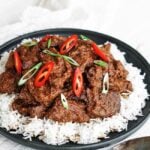
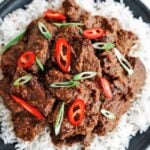
No, but I cannot wait to try it!